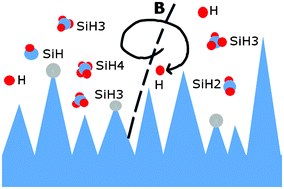Low pressure plasma assisted silicon nanowire growth from self organised tin catalyst particles
Abstract
We present results on the growth of silicon

* Corresponding authors
a
Department of Engineering & Design, London South Bank University, 103 Borough Road, London, SE1 0AA, UK
E-mail:
ballj6@lsbu.ac.uk
Tel: +44 (0)2071857509
b
Department of Physics, Durham University, South Road, Durham, DH1 3LE, UK
E-mail:
leon.bowen@durham.ac.uk
Fax: +44 (0)19 1334 5823
Tel: +44 (0)19 1334 3680
c
Department of Physics, Durham University, South Road, Durham, DH1 3LE, UK
E-mail:
b.g.mendis@durham.ac.uk
Fax: +44 (0)1913345823
Tel: +44 (0)19 1334 3554
d
Department of Engineering & Design, London South Bank University, 103 Borough Road, London, SE1 0AA, UK
E-mail:
reehalhs@lsbu.ac.uk
Tel: +44 (0)20 7815 7513
We present results on the growth of silicon

 Please wait while we load your content...
Something went wrong. Try again?
Please wait while we load your content...
Something went wrong. Try again?
J. Ball, L. Bowen, B. G. Mendis and H. S. Reehal, CrystEngComm, 2013, 15, 3808 DOI: 10.1039/C3CE00036B
To request permission to reproduce material from this article, please go to the Copyright Clearance Center request page.
If you are an author contributing to an RSC publication, you do not need to request permission provided correct acknowledgement is given.
If you are the author of this article, you do not need to request permission to reproduce figures and diagrams provided correct acknowledgement is given. If you want to reproduce the whole article in a third-party publication (excluding your thesis/dissertation for which permission is not required) please go to the Copyright Clearance Center request page.
Read more about how to correctly acknowledge RSC content.
 Fetching data from CrossRef.
Fetching data from CrossRef.
This may take some time to load.
Loading related content
